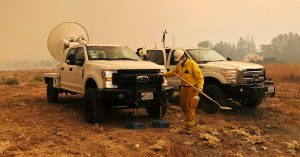Tesla must be testing me. First there was this failed Armor Glass demo at last week’s unveiling of the company’s Cybertruck prototype. Now it’s this video of a tug-of-war between the Cybertruck and a Ford F-150. An uphill tug-of-war!
Yes, it’s pretty awesome. But this isn’t a contest of power or torque—it’s a battle of mass. As long as both vehicles have sufficiently powerful engines, the more massive one will win. Why? It’s all about friction and the interaction between the tires and the road. The Tesla Cybertruck, with its steel outer shell, is probably more massive than a Ford F-150.
Let’s be clear. Friction is pretty complicated. You have all of these atoms on the surfaces of two objects that are interacting with each other—that’s not so simple. But don’t worry, there’s a fairly easy way to model this interaction. Here is an expression for the magnitude of a frictional force between two non-sliding (or ‘static friction’) surfaces.
I’m going to go over each part of this model, but first how about a demo? Take a book or block or something similar and put it on a flat table. Now push on it from the side—but not so hard that it moves. Here, like this:
Since the block doesn’t move (technically because it doesn’t accelerate), the net force on the object is zero newtons. That means the amount you push to the right is equal in magnitude to the frictional force pushing to the left. Now try pushing on the side while also pushing down on the block:
Now you can push harder on the side without causing the block to move, right? That means the frictional force has increased. To understand why, we need to recognize there’s another force at work: When you push down on the block, the table pushes up on it with an equal and opposite force—basically to prevent the block from accelerating through the table. We call that the “normal force,” because it’s perpendicular to the surface. It’s the same kind of force that keeps you from plunging through the sidewalk under the effect of Earth’s gravity.
That’s the key to the whole thing. The magnitude of the frictional force depends on the magnitude of the normal force. So the harder you push down, the more frictional resistance there will be to a sideways motion.
What about the other stuff in the friction model? Here are a couple of notes:
- What does the “less than or equal” sign mean? The static frictional force is called a force of constraint. This means it has a magnitude of whatever is needed to keep the two surfaces at rest relative to each other—up to some maximum point.
- The μs is the coefficient of static friction. This is a unitless value that depends on the two types of materials interacting. The coefficient of static friction for tire rubber on asphalt is somewhere around 0.7.
But what does this have to do with mass of a truck? Suppose I have a truck that’s pulling some other truck. Here is a force diagram for such a situation.
Since the truck doesn’t accelerate up or down, the forces in the vertical direction must add up to zero Newtons. That means the normal force must have the same magnitude as the downward gravitational force. The gravitational force depends on the mass of the object, such that a heavier object will have a greater normal force.
What about the horizontal direction? In the tweeted video, the Cybertruck has a rope attached to it. This rope pulls with some tension force to the right, and the friction between the tires and the ground push to the left. The frictional force must be at least a little bit greater than the backwards-pulling friction, so that the truck can accelerate (and start to move). But here you can see the key point. More mass means a greater normal force, which in turn produces a greater frictional force. Mass matters.
Oh, but you still don’t buy it? Wouldn’t a more powerful truck win this tug-of-war? How about a nice demonstration? Here I have two battery-powered toy cars. The red car runs on 2 C cell batteries. The blue one is running on just 1 C battery, making it not as strong. What happens when these two cars have a tug-of-war?
No surprises here. The car with two batteries wins. But wait! What if I add mass to the car with only one battery? This is what happens.
Check that out. The car with only one battery won. It’s the mass that matters. Oh, but what about on an incline? Ok, it’s harder to win this contest if you are pulling uphill—but mass still matters the most. Here is a diagram of a Tesla truck pulling a car up a hill.
What’s different in this case? First, the normal force is smaller. Since the truck is on an incline, only part of the gravitational force pushes the truck into the road. That means the force with which the road pushes back also has to be smaller. With a smaller normal force you get less friction.
But wait! It’s even worse. Now part of the gravitational force is pulling in the direction of the tension in the rope. The lower frictional force has to be equal to the sum of the rope’s tension and the component of gravity that’s parallel to the road. So this tug-of-war is much harder to win. But you know what? As long as you have a strong enough engine, friction and the mass of the vehicle are still going to be the deciding factors.
It seems like the Tesla Cybertruck is fairly unique and pretty cool. I’m not sure why they would make a demo like this tug-of-war, though, just to show it’s heavier than an F-150.
More Great WIRED Stories
- The strange life and mysterious death of a virtuoso coder
- Alphabet’s dream of an “Everyday Robot” is just out of reach
- Wish List 2019: 52 amazing gifts you’ll want to keep for yourself
- How the climate crisis is killing us, in 9 alarming charts
- How to lock down your health and fitness data
- 👁 A safer way to protect your data; plus, the latest news on AI
- 🏃🏽♀️ Want the best tools to get healthy? Check out our Gear team’s picks for the best fitness trackers, running gear (including shoes and socks), and best headphones.



